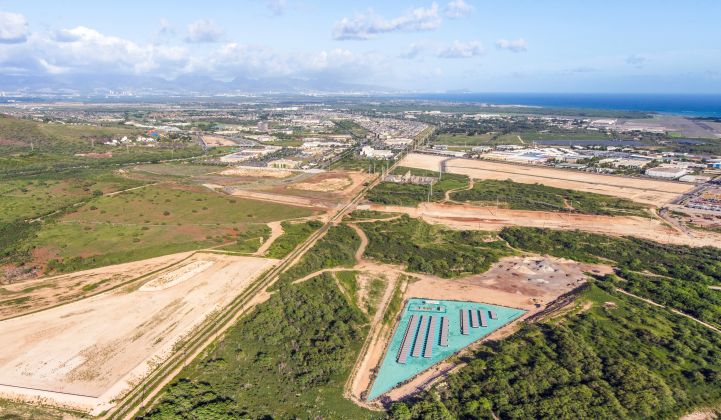Earlier this month Hawaiian Electric announced a slew of solar-plus-storage projects to continue its shift to fossil-free energy. Tucked inside that announcement was a big development: a massive grid-tied battery that will take over crucial duties from the last coal plant anywhere in Hawaii.
The 185-megawatt/565-megawatt-hour Kapolei Energy Storage project marks a dramatic arrival to the big leagues for developer Plus Power. The 15-person shop, based in San Francisco’s homey Inner Sunset district, had previously developed a 12-megawatt battery to ensure reliability at a car factory microgrid in Mexico.
Its new project will sit a mile and a half from the 180-megawatt AES coal plant on the west side of Oahu. With its ample capacity, the battery will both shift power from the solar-flooded midday hours to the evenings and deliver fast frequency response to keep the grid humming. The coal plant provided grid inertia with the spinning mass of its turbine, but Kapolei will replicate that service with advanced inverters.
“The grids in Hawaii have always been out in front in terms of renewable energy,” lead developer Bob Rudd told Greentech Media. “A battery of this scale is going to have a direct impact on an island grid such as this in allowing the transition away from conventional generation to more renewable energy.”
If approved by regulators, the battery will come online in June 2022, ahead of the coal plant retirement in September of that year. Other winning bids selected by Hawaiian Electric were backed by Engie, Innergex and HECO itself.
Rising above Hawaii's tsunamis
Rudd has closed groundbreaking deals in Hawaii before. In his previous role at Tesla, he developed a large-scale solar-plus-storage project for the Kauai Island Utility Cooperative, well before such projects were common.
“What I've learned working in Hawaii is that community engagement and local support and collaboration is critical to project success,” he said. “We made every effort early on to engage with local community members.”
As a result, the project already cleared permitting approvals with the local Neighborhood Board as well as the City and County of Honolulu.
The battery will sit on eight acres of industrial-zoned land owned by Kapolei Properties, part of the Hawaii-based real estate firm James Campbell Company. It will sit 55 feet above sea level, near an engineered harbor that provides physical barriers in the event of tsunamis or sea-level rise.
Hawaii was the first state to commit to 100 percent renewable power by 2045. As a series of island grids, it has to balance supply and demand over much smaller territories than other states. But since it had to import fossil fuels to burn, renewables and batteries became cost-competitive there earlier than many places on the mainland.
HECO’s latest portfolio will push the state even further down the renewable path. If it all gets approved and built, the utility will add 460 megawatts of solar capacity and nearly 3 gigawatt-hours of storage. The scale of development is hard to find elsewhere, outside of much-larger California.
“As all of the projects that Hawaiian Electric is working on come online, they're really advancing the grid in general in terms of what can be done with renewable energy and battery storage,” Rudd said.
Plus Power’s contribution will rank among the largest batteries in the world — a rarefied echelon that will grow considerably more crowded in the next three years. But, Rudd noted, it is “definitely not the largest project” in the company’s development portfolio.
“We’re growing, and we’re hiring,” co-founder Brandon Keefe added.




